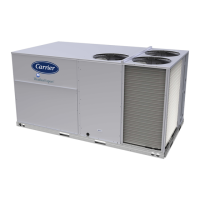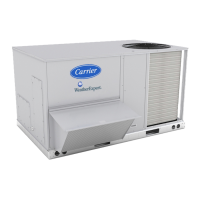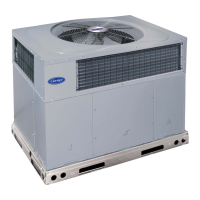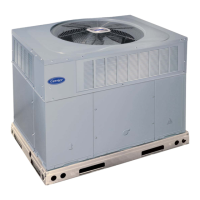26
Unoccupied Free Cooling
The unoccupied free cooling algorithm attempts to maintain the
buildi ng space half way betw een the Occupied Cool Set Point (OCC
COOL SETPOINT) and Occupied Heat Set Point (OCC HEA T
SETPOINT) usi ng only the econom i zer when t he conditions in the
building and the outdoor s a re suitable, during unoccupied per i ods.
Three different poi nt s def i ne this algorithm: Unoccupied Free Cool i ng
configuration (WHEN TO UNOCC FC), Free Cooling Pre occupa ncy
T i me c onf igurat ion (UFC PREOCC TIM E) , and Fre e c ool ing allowed
(OK TO FREE COOL?).
WHEN TO UNOCC FC = 0(Disabled)
Free Cooling will only occur if the space exceeds the unoccupied
setpoints.
WHEN TO UNOCC FC = 1 (Preoccupancy)
Unoccupied free cooling can only occur when the time until the
next occupied period is less than the Unoccupied Free Cool
Pre--Occupancy Time (UFC PREOCC TIME) in minutes.
WHEN TO UNOCC FC = 2 (Unoccupied)
Unoccupied free cooling can occur throughout the entire
unoccupied period. The space temperature must be higher then the
mid-- point between the occupied cooling and heating setpoints.
Power Exhaust
Power Exhaust is a function used to assist in the building exhaust
air if the barometric relief damper is not enough. It can be one or
two motors which can be controlled independently to provide 2
stages of exhaust. These two power exhaust stages are controlled
by relays on the Main Base board, and therefore need to be
configured on relay channels. To assign the channels set the PE1
RELAY CHANNEL and PE2 RELAY CHANNEL as needed.
NOTE: Factory installed power exhaust is only one channel and is
on Relay 06.
When a power exhaust 1 relay channel is configured, the control
will create a PE1 curve, example shown in Fig. 20. This curve is
created by applying the difference of the power exhaust stage 1 at
maximum fan speed (PE1 POS @ MAX SPD) and the Economizer
minimum at maximum fan speed (MIN POS @ MAX FAN) in
relationship to the minimum position curve. When a power exhaust
2 relay channel is configured, the control will create a PE2 curve,
example shown in Fig. 20. This curve is created by applying the
difference of the power exhaust stage 2 at maximum fan speed
(PE2 POS @ MAX SPD) and the Economizer minimum at
maximum fan speed (MIN POS @ MAX FAN) in relationship to
the minimum position curve.
Power exhaust 1 (PE1 RELAY) and power exhaust 2 (PE2
RELAY) are controlled using their respective curves as a threshold.
When the operating point of the Commanded Fan Speed (IDF
SPEED OUTPUT) and Economizer Commanded Position
(ECON CMD POSITION) is above the power exhaust 1 curve,
the Power exhaust 1 (PE1 RELAY) will be turned on. When the
operating point falls below the curve minus the power exhaust turn
off deadband (PE OFF DEADBAND) the Power exhaust 1 (PE1
RELAY) will be turned off. Power exhaust 2 operates the same as
Power exhaust 1 except using the PE2 curve.
Indoor Air Quality (IAQ)
Indoor air quality is typically measured using a CO
2
sensor whose
measurements are displayed in parts per million (ppm). Outdoor air
quality may be measured with a CO
2
sensor for indoor--outdoor
differential demand ventilation control. The factory--installed
indoor air quality CO
2
sensor is mounted in the return section. A
field--installed indoor air quality CO
2
sensor may be mounted in
the return or in the occupied space. The indoor air quality modes of
operation can be affected by the IAQ Analog Input Config
(ANALOG IAQ CTRL) and other related and limit configurations
as described below.
Indoor Fan Speed
Damper Position
Econo Max
Position
(DAMPMAX)
(MP_SPD2,
MP_POS2)
(MP_SPD3,
MP_POS3)
Maximum Speed
(SPEEDMAX)
(MP_SPD1,
MP_POS1)
10%
MINP_MAX
Minimum Position Curve
Key:
(PE1_SPD3,
PE1_POS3)
(PE1_SPD2,
PE1_POS2)
(PE1_SPD1,
PE1_POS1)
PE1PMAX
Power Exhaust 1Curve
(PE2_SPD3,
PE2_POS3)
2(PE2_SPD2,
PE2_POS2)
(PE2_SPD1,
PE2_POS1)
Power Exhaust 2 Curve
PE2PMAX
C14327
Fig. 20 -- Power Exhaust Operation Curves

